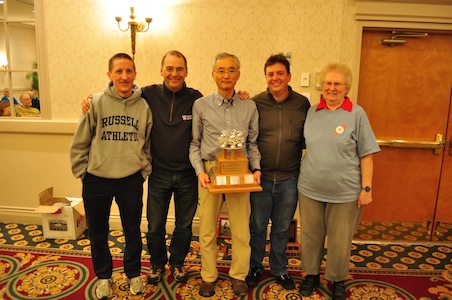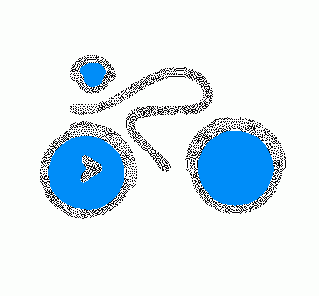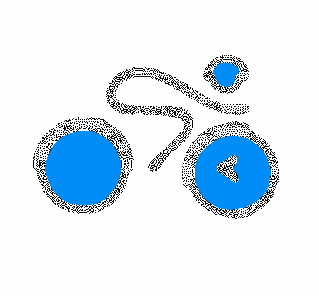|
Suffer
Or: How I tripled my lifetime brevet mileage in 5 weeks
by Ben Coli
Five weeks ago, I had 600 BC Randonneur kilometers under my belt: two 200s last year, and the Early Bird 200 this year. Now I'm standing at 1812 km, not including permanents and populaires.
The 300 at Eau de Hell was no damn good. It rained for about 15 of the 17 hours I was on the road. I discovered that I couldn't eat more than two Clif bars in a day anymore, and all I had with me was Clif bars, so I had to stuff my pockets with anything else I could find along the way. I stopped for a snack four times in the last 40 km and I arrived at the Best Western at midnight, where I had a meal of processed insta-food from the vending machine. Fortunately, I had a beer in the fridge in my room.
The next weekend, I decided to infect my wife Erin with randonneuring and I took her out for the lower mainland spring 200. The weatherman said sun, but the sky said hail and headwind. At km 150 Erin was hurling abuse at the cosmos and cursing her own hubris, but at the finish she was all smiles and ecstasy. She'll be back.
The weekend after that I didn't ride any brevets. It was my first wedding anniversary. Erin and I stuck together for a whole year, in spite of the previous week's brevet. We cycled out to Whytecliff park and had a picnic in the sun on the rocks overlooking the ocean. Cycling can be like this; it doesn't have to be painful. It can be fun and beautiful and it can involve a bottle of wine.
The following weekend I rode the lower mainland spring 300. My last 300 was so terrible that I had to try another, either to clear the air with a successful ride, or to establish once and for all that 300 kilometers is too far for a human being to ride in a single day.
Unfortunately, I had a really good ride. Sure, I had knee pains at km 200 that I thought would make me DNF, and 3 km short of the 220-km control the sky opened up and drenched me and six other riders in an ill-timed downpour that lasted about 10 minutes, but I finished in 15 hours and I never bonked once. I discovered to my great dismay that Gatorade is to randonneurs what votes are to politicians. I hate Gatorade, and now I'm stuck with it for as long as I ride brevets.
The next weekend came the Fleche.
Shiro Ogawa's first brevet was my first brevet, and his second was my second. We rode together for a while on the Fall Flatlander and he decided that we were compatible riders, so when he was looking for a partner to ride permanents with in January, he picked me. I had no intention of riding 200 km in the dark freezing rain of January, but his entreaties were so earnest that it broke my heart to think of him out there in the rain alone, so I went with him.
And I went with him again in February. Why not? It'd be a waste of that January permanent if I didn't keep my BC-12 eligibility alive.
Shiro started talking about how I would join him on his Fleche team and I leapt at the opportunity to tell him no. No, I didn't have proper lights for my bike; no, I didn't think I'd be ready to ride that distance at the beginning of May; and no, I didn't feel the need to ride the Fleche this year. I could take this randonneuring thing slowly. I have years to let the habit build up on me.
But still, I was 34 and Shiro 66, which would put us in a great position to win the "Lungs are for Life" trophy if we managed to dupe a couple of idiots into riding with us.
Dupes proved to be easy to find. At the spring social it was enough to talk about the Fleche in Alex Pope's presence for him to volunteer to join us without being asked. At the spring 200 I mentioned the Fleche in front of Colin Fingler and we had our team. I nominated Shiro as our captain, but Shiro wasn't having it; he insisted that Alex should be captain because he was the most experienced rider. Colin named our team. I can't remember the name and I could never pronounce it. If you want an explanation, ask Colin.
For some reason, it fell to me to design the route. I had no idea what it took to make a good Fleche route, and I had certain restrictions. We couldn't cross the border because Shiro's a Japanese citizen and didn't want to put up with the hassle, and Colin had misplaced his passport, anyway. I cobbled together bits and pieces of other brevets and came up with something just over 400 km in length, with a few hills in the early going and a lot of Tim Horton's controls toward the end.
lex had a look at my route, overlooked all of the little stupidities in it, and suggested that we reverse the direction of the course so we could have a short sleep control at his house in the middle of the night. The sleep control would be nice, but all of the hills were now in the last 80 km of the route. Alex seemed to think that was fine and he was going to have to climb all of those hills with us, so who was I to argue?
We set out Saturday morning into one of those fine drizzles that seem to be coming from all directions at once. We rode in a disciplined paceline down highway 7 to Hope. It's a pleasure to paceline behind Alex; he's so steady in the saddle, so predictable, so true in his line. You can get within half a wheel-length and just zone out, knowing that he's not going to do anything crazy. Colin is good, too; he rarely swerves unnecessarily and holds a steady pace. Shiro, on the other hand, swerves and jinks like a B-17 bomber dodging flak over Dusseldorf, even when he's not tired.
I may sound like I'm bad-mouthing Shiro, but he is one of my favourite randonneurs. You develop a certain affection for anyone who sticks with you when you're bonking in Surrey on a permanent in February. If you haven't met Shiro, I strongly recommend you seek him out; he's hilarious. He can be hard to understand, but he's worth the effort - his English is great, it's just his accent that sometimes gets in the way. He's really worth riding with, too, because he suffers so well. He never gets angry or resentful with his self-inflicted situation the way I do, he just takes it. The only time he gets riled up is when someone in a car does something stupid, and then he swears at them in Japanese, which is something you shouldn't miss.
Heading back east, the drizzle got heavier and heavier until it officially became rain. Crossing the Agassiz-Rosedale bridge (one of the little stupidities of my route) we thoroughly soaked our feet with our own tire spray because the engineers seem to have neglected to put any drains in the bridge deck. That was the last time I'd have dry feet for a whole day.
A girl with a mop glared at us as we walked wetly into our first Tim Horton's control at Vedder Crossing, km 100. Shivering and dripping wet, we sat down for sandwiches and hot chocolate, and we shared stories about past brevets. All of Alex's stories seemed to end in a DNF for a very good reason, such as "I was riding over the Coquihalla connector and we got hit by a blizzard, so I hitched a ride."
Out of the blue, Shiro asked, "do you guys ever wonder why we do this?"
Man did we laugh. I assume we were all laughing for the same reason. Isn't it the central existential question of every randonneur? Don't we all ask ourselves that at least once on every brevet we ride? I sure do. On at least 3/4 of the brevets I've done, I've either wondered if I'd have to DNF, or I've wished I could. After the Eau de Hell 300, I told people, "I'd have DNF'd, if I only knew how."
Back on the bike, out in the cold, we all waited for Colin to get moving after he forgot he'd put a lock around the back wheel of his bike and tried to ride away with the lock still on - as if the good folks of Vedder Crossing would even want a bike without a motor. Rolling into the left-turn bay at Vedder Road, Colin noticed that the makeshift mudflap on Shiro's el-cheapo back fender was vibrating, wagging like a dog's tail.
"Are you shivering?" Colin asked.
Shiro hadn't brought along warm enough clothes for the weather. "Do you know what I do when I get cold?" he asked. Colin shook his head. "I suffer," Shiro said. "It's the Japanese way."
The rain let up and 30 km down the road an ominous sphere of flame started to show itself through the leaden shroud of water vapour we in Vancouver call "the sky". Alex led the paceline for about 3 km on one pull before dropping back. On his next pull, I noticed him shifting around in the saddle a lot and standing on his pedals a little too frequently. I thought to myself, "I wonder if Alex is going to DNF."
Not 5 kilometers further, we reached highway 13 and Alex announced that he was going to abandon. His longest ride to date that year had been 45 kilometers and his shoulders and back couldn't take it. We'd gotten too close to his house for him to carry on. Alex surrendered the spare dry route sheets he'd been carrying and he promised us that he'd be waiting for us at his house with hot food when we arrived in the middle of the night.
So there we were, de-captainated.
But we carried on, as one does in such circumstances. The day shaped up to be pretty nice for riding. We saw the sun in all its glory, and while insane weather was breaking out all over the Fraser Valley, (it hailed on Alex on his way home and my wife reported overflowing storm sewers in Vancouver) we lucked out and didn't see any of it. We could see a black cloud dumping on Tsawwassen, but by the time we got there it was gone; looking ahead, we saw a horrible storm punishing Point Grey, but when we reached UBC the pavement was mostly dry. Shiro said, "when the sun is shining, I never ask myself why I'm doing this."
We filled ourselves up with Chinese noodle soup at UBC and the sun departed for Asia. On our way across Vancouver we stopped at a convenience store on 2nd Avenue near Granville Island and I learned why you don't want to design a route that crosses Vancouver on a Saturday night. While Shiro resupplied himself with snacks, I got accosted by a drunk who tried persistently, and in the friendliest way imaginable, to pick a fight with me. He told me he'd walked away from a wedding, where he was suffering - nobody could understand or imagine how he suffered.
It reminded me of someone I'd seen on Commercial Drive just a week before. A man walked past me on the Drive half-yelling, "for weeks I've been walking up and down this street, screaming about how I'm suffering..." He seemed indignant that nobody had taken the time to notice his suffering. What, did he expect someone to call a reporter from the Sun? I can imagine the headline: "Self-absorbed man too wrapped up in own suffering to notice others also suffering."
I've heard all kinds of reasons for DNFing and I knew it would make a great story, but I didn't want to become the first BC Randonneur to DNF because of a fistfight with a drunk. I firmly and politely talked him down until Shiro got out of the store and we got the hell out of there.
We crossed Vancouver, Burnaby, Coquitlam and PoCo. Colin marveled at my navigational talent. It was my route. I knew the roads. I seldom even turned on my headlamp to look at the route sheet. We crossed the Pitt River bridge and made it to Alex's house at about 1:30 AM. Alex was up and waiting. He fed us and he threw our socks, gloves and toques in the dryer. We had planned to spend 2 hours at Alex's house, but we were behind schedule, so after a 15 minute nap on the floor in front of the fireplace, we forced ourselves to get back on the bike.
It had recommenced raining. Now the suffering began. Now, 330 km into the ride, we started on all of those hills that had seemed like a good idea to me when I put them in the beginning of the original route: Dewdney Trunk Road with its rollers and the climb up Keystone. To make things worse, we knew that flat, reliable Lougheed highway ran parallel to our route the whole way, but we submitted the route and now it was ours to suffer through.
I groggily climbed the hills and focused on the magical minimum distance of 360 km. The hills, slowly, one-by-one, were put behind us. We passed the 360-mark and made it down to the Lougheed highway. We had our 22-hour control on Nicomen Island, at km 375 of our route. We realized that the 25 km minimum we were required to ride in the final 2 hours would put us right around the peak of Mt. Woodside. If we'd only gone slower and had our 22-hour control earlier, we could have skipped Woodside, but now we didn't have a choice.
I got so tired that I worried about falling off my bike. Colin gave me a piece of gum, which may have saved my life, or at least my bike and portions of my skin. We climbed Woodside. It wasn't that bad. If we'd done the route the way I'd originally planned it, we'd have had to climb it from the steep side.
If you want to suffer less, design a flatter Fleche route. Or better yet, you could really minimize suffering by not doing the Fleche at all. Why are we doing this? Certainly not to avoid suffering. Might as well put some hills in the route; they keep things interesting. Might as well make it as far as you can before that 22-hour control; otherwise you'd miss Mt. Woodside, and then you wouldn't have that to look back on.
Shiro developed some knee pain in the last half hour. I couldn't help but smile; I'd been doping myself with Advil all day for a pain in my knee that had cropped up around km 100.
We ran out of time four kilometers short of Harrison. We signed each other's control cards and congratulated ourselves. 412 kilometers was enough to be considered a success.
And we felt good. Or I did, anyway. I assume the others did, too. After all, they keep getting back on the bike.
When you tell someone you're riding 400 km and they ask you how many days it will take you, you know why you’re doing it. Why would you want to be mortal?
"The struggle itself towards the heights is enough to fill a man's heart. One must imagine Sisyphus happy."
- Albert Camus, The Myth of Sisyphus

Alex, Colin, Shiro, Ben and presenter Rita Pollock
Photo: Patrick Wright
-
May 13, 2011
|



